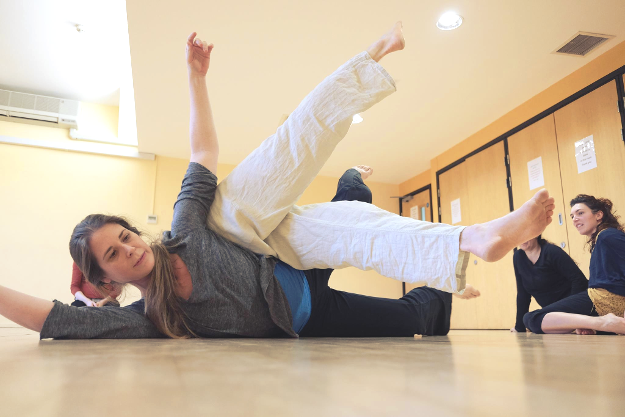I started teaching Contact Improvisation at Oxford Contact Dance in 2015. But how do we teach contact improvisation – it’s an improvised dance after all.
Malcolm Manning teaches dance and he talks about it in: ‘On Teaching Contact Improvisation (2009)‘. He describes two ways of teaching – although there are many more – contrasting the teaching of an ‘IKEA’ kit of movements or known vocabulary, with one which is more explorative and investigative. He examines teaching ‘table position’ in this regard but recently I came across an example which might also have illustrated the point he was making. At least, I hope so!
Rolls
There are lots of ways to roll across the floor and travel. Spiral rolls and crescent rolls are widely taught. Both are rolls about the spine where the spine is an axis of rotation. There’s specific ways of achieving these rolls by sequencing the movement of body and limbs.
For example – a spiral roll, travelling on the floor to the left: lie on your back; fold your right knee and ankle over your left knee and ankle; allow the torque to roll your pelvis counter-clockwise, press your right foot to the floor and draw it along the ground; push your right leg down and straighten it; let the pelvis continue until it falls and you are face down on the ground ie 180 degrees of movement. Now use your left arm and stretch it to your right allowing your left shoulder to pull away from the floor as it follows your hand and arm; let the movement reach your pelvis and rotate it counter-clockwise until you are on your back. Now you have completed one rotation of the roll. Repeat this action until you have completed your travelling.
Another approach to rolls
When I attended London Contact Improvisation last month, another more exploitative way of studying rolls was facilitated by Manuela Sarcone. The emphasis was on being curious and investigation.
We are to travel across the hall from one end to the other by rolling on the floor. Manuela demonstrates a way of rolling which sets the context as a roll about the spine. But then goes-on to describe the exercise as a whole.
Initially, we can move any way we like – freestyle! Next, we must roll but keeping our head off the ground – back and forth across the floor. In our third traversal, our pelvis must be kept off the ground; and finally we must repeat the travelling but keeping our feet off the ground. In all of these rolling exercises, any other part of the body may touch the ground and only one part of our body must be off the ground.
Which is the better way to teach?
When we teach technique then people often discover movement practices. Do you remember the first time someone showed you a technique for spiral rolls?
But we must encourage discovery without teaching technique too. For without allowing discovery then contact improvisation would be alot less improvisational. Hence, improvisation is also a learnt skill too.
